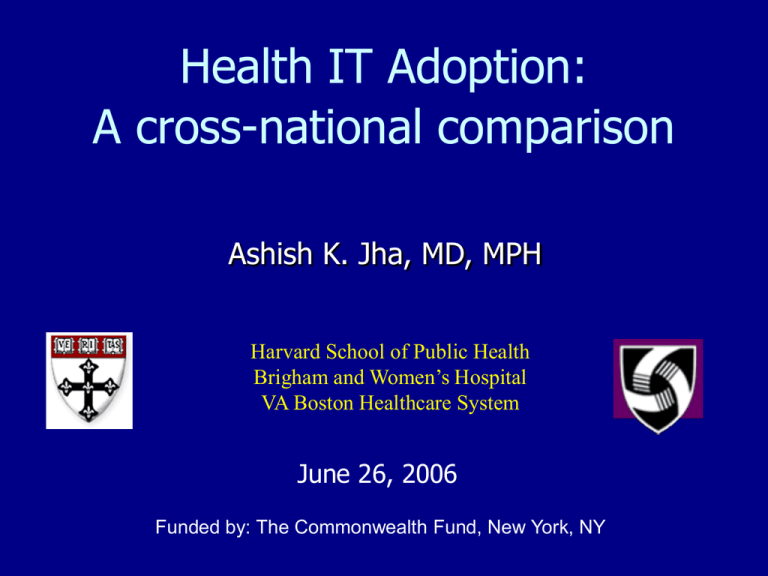Health IT Adoption: A cross-national comparison Ashish K. Jha, MD, MPH
advertisement

Health IT Adoption: A cross-national comparison Ashish K. Jha, MD, MPH Harvard School of Public Health Brigham and Women’s Hospital VA Boston Healthcare System June 26, 2006 Funded by: The Commonwealth Fund, New York, NY Background Healthcare costs rising in many nations Quality of care variable, often inadequate The promise of health information technology Will increase quality Will improve efficiency Will improve coordination of healthcare Despite major policy focus Level of HIT adoption in the U.S. unknown How U.S. compares to other nations also unknown Research Questions What is the level of HIT adoption in the U.S.? How does it compare to other nations? What are the major programs currently in HIE? Methods A comprehensive review of U.S. surveys Rating of surveys based on methodology, content Ratings criteria developed by group of experts: Sampling technique, response rate EHR content Reviews of surveys from other nations Interviews from experts Results Health IT in the U.S. 35 surveys of physicians and other providers 21 surveys available for rating 16 surveys of EHR adoption in ambulatory care 5 surveys of EHR adoption in inpatient care Few surveys of high quality Nine high quality in methodology Eight high quality in EHR content Four surveys high quality in both areas Results – U.S. EHR adoption Range: Medium or High Quality Surveys Best Estimates: High Quality Surveys 17% to 25% 17% 12.9% to 13% 13% Large groups* 19% - 57% 39% EHR: hospitals 16%† - 59%†† None CPOE: hospitals 4% to 21% 5% EHR: ambulatory Solo practitioners Cross-national comparison Primary Care Hospital Care EMR CPOE EMR CPOE USA 17-18% N/A 16% 5% UK >90% >90% 8% 3% Canada 19% 14% <10% 25% Australia 90% 75% <10% <1% New Zealand 72% 90% <10% <1% Netherlands 95% 90% <5% <5% Health Information Exchange USA Regional Health Information Organizations 7-10 RHIOs “functioning” 100+ in planning stages England National Program for Health IT: Ambitious plan Canada Infoway: Imaging, labs, medications integration Early stage: 8% to 27% complete Australia HealthConnect: $128M over 4 years National backbone network National sharing of data for imaging, prescriptions, clinical data Still very early in deployment with some early hurdles Slow efforts with small investments mostly focused on broadband connection Little data sharing occuring New Zealand Little activity in data exchange Netherlands National pilot programs in fall, 2006 Two main features: electronic medication records Clinical data summary 4000 Euros for GPs; 40,000 for pilot hospitals Discussion U.S. adoption rates of EHR low Lack of good estimates Less than 1 in 5 ambulatory physicians using EHR Approximately 1 in 20 hospitals using CPOE Other nations ahead on ambulatory EHR U.S. has lowest rate of EHR use in ambulatory care Substantially behind Australia, UK, NZ and Netherlands Lack of high quality data make other assessments difficult Discussion Poor adoption rates in hospitals No nation has moved substantially in this area Different levels of activity on data exchange Major efforts in UK, Canada, and Netherlands Slower efforts in US, Australia, and NZ Even well touted programs running into obstacles Limitations Important caveats to adoption data U.S. estimates based on few high quality surveys Large confidence intervals when other surveys included Data from other nations not rigorously evaluated Most surveys don’t distinguish “have” from “use” Field rapidly changing Implications Health IT adoption varies across nations U.S. behind in ambulatory EHR use Likely will need greater access to capital to improve IT in hospitals widely neglected Best evidence for improving care New efforts to focus on hospital IT HIE very early in deployment No single approach will work for all nations Adequate funding just part of the challenge Acknowledgement HIT Adoption Initiative – funded by ONC Tim Ferris Karen Donelan Alex Shields Cait DerRoches Sara Rosenbaum David Blumenthal Cross-country Initiative – funded by CMWF Doreen Neville Tim Clark David Doolan David Bates





